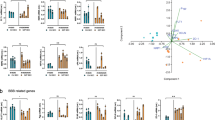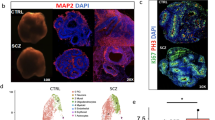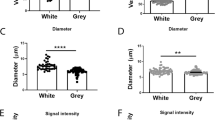Abstract
Although there is convergent evidence for blood-brain barrier (BBB) dysfunction and peripheral inflammation in schizophrenia (SZ) and bipolar disorder (BD), it is unknown whether BBB deficits are intrinsic to brain microvascular endothelial cells (BMECs) or arise via effects of peripheral inflammatory cytokines. We examined BMEC function using stem cell-based models to identify cellular and molecular deficits associated with BBB dysfunction in SZ and BD. Induced pluripotent stem cells (iPSCs) from 4 SZ, 4 psychotic BD and 4 healthy control (HC) subjects were differentiated into BMEC-“like” cells. Gene expression and protein levels of tight junction proteins were assessed. Transendothelial electrical resistance (TEER) and permeability were assayed to evaluate BBB function. Cytokine levels were measured from conditioned media. BMECs derived from human iPSCs in SZ and BD did not show differences in BBB integrity or permeability compared to HC BMECs. Outlier analysis using TEER revealed a BBB-deficit (n = 3) and non-deficit (n = 5) group in SZ and BD lines. Stratification based on BBB function in SZ and BD patients identified a BBB-deficit subtype with reduced barrier function, tendency for increased permeability to smaller molecules, and decreased claudin-5 (CLDN5) levels. BMECs from the BBB-deficit group show increased matrix metallopeptidase 1 (MMP1) activity, which correlated with reduced CLDN5 and worse BBB function, and was improved by tumor necrosis factor α (TNFα) and MMP1 inhibition. These results show potential deficits in BMEC-like cells in psychotic disorders that result in BBB disruption and further identify TNFα and MMP1 as promising targets for ameliorating BBB deficits.
This is a preview of subscription content, access via your institution
Access options
Subscribe to this journal
Receive 12 print issues and online access
$259.00 per year
only $21.58 per issue
Buy this article
- Purchase on Springer Link
- Instant access to full article PDF
Prices may be subject to local taxes which are calculated during checkout




Similar content being viewed by others
Data availability
Data as well as data cleaning are available upon request to the corresponding author.
Code availability
Analysis code is available upon request to the corresponding author.
References
Murray CJL, Vos T, Lozano R, Naghavi M, Flaxman AD, Michaud C, et al. Disability-adjusted life years (DALYs) for 291 diseases and injuries in 21 regions, 1990–2010: a systematic analysis for the Global Burden of Disease Study 2010. Lancet. 2012;380:2197–223.
Martin J, Taylor MJ, Lichtenstein P. Assessing the evidence for shared genetic risks across psychiatric disorders and traits. Psychol Med. 2018;48:1759–74.
Pong S, Karmacharya R, Sofman M, Bishop JR, Lizano P. The role of brain microvascular endothelial cell and blood-brain barrier dysfunction in schizophrenia. Complex Psychiatry. 2020;6:30–46.
Liebner S, Dijkhuizen RM, Reiss Y, Plate KH, Agalliu D, Constantin G. Functional morphology of the blood–brain barrier in health and disease. Acta Neuropathol. 2018;135:311–36.
Hwang Y, Kim J, Shin J-Y, Kim J-I, Seo J-S, Webster MJ, et al. Gene expression profiling by mRNA sequencing reveals increased expression of immune/inflammation-related genes in the hippocampus of individuals with schizophrenia. Transl Psychiatry. 2013;3:e321.
Greene C, Hanley N, Campbell M. Claudin-5: gatekeeper of neurological function. Fluids Barriers CNS. 2019;16:3.
Cai HQ, Catts VS, Webster MJ, Galletly C, Liu D, O’Donnell M, et al. Increased macrophages and changed brain endothelial cell gene expression in the frontal cortex of people with schizophrenia displaying inflammation. Mol Psychiatry. 2018. https://doi.org/10.1038/s41380-018-0235-x.
Katsel P, Roussos P, Pletnikov M, Haroutunian V. Microvascular anomaly conditions in psychiatric disease. Schizophrenia—angiogenesis connection. Neurosci Biobehav Rev. 2017;77:327–39.
de Klerk OL, Willemsen ATM, Bosker FJ, Bartels AL, Hendrikse NH, den Boer JA, et al. Regional increase in P-glycoprotein function in the blood-brain barrier of patients with chronic schizophrenia. Psychiatry Res Neuroimaging. 2010;183:151–6.
Hoosain FG, Choonara YE, Tomar LK, Kumar P, Tyagi C, du Toit LC, et al. Bypassing P-glycoprotein drug efflux mechanisms: possible applications in pharmacoresistant schizophrenia therapy. BioMed Res Int. 2015;2015:1–21.
Kimchi-Sarfaty C, Oh JM, Kim I-W, Sauna ZE, Calcagno AM, Ambudkar SV, et al. A ‘silent’ polymorphism in the MDR1 gene changes substrate specificity. Science. 2007;315:525–8.
Martínez-Magaña JJ, Genís-Mendoza AD, González-Covarrubias V, Jiménez-Guenchi J, Galindo-Chávez AG, Roche-Bergua A, et al. Exploratory analysis of rare and novel variants in Mexican patients diagnosed with schizophrenia and dementia. Rev Investig Clín. 2019;71:1879.
Girard SL, Gauthier J, Noreau A, Xiong L, Zhou S, Jouan L, et al. Increased exonic de novo mutation rate in individuals with schizophrenia. Nat Genet. 2011;43:860–3.
Najjar S, Pahlajani S, De Sanctis V, Stern JNH, Najjar A, Chong D. Neurovascular unit dysfunction and blood–brain barrier hyperpermeability contribute to schizophrenia neurobiology: a theoretical integration of clinical and experimental evidence. Front Psychiatry. 2017;8:83.
Hoang D, Xu Y, Lutz O, Bannai D, Zeng V, Bishop JR, et al. Inflammatory subtypes in antipsychotic-naïve first-episode schizophrenia are associated with altered brain morphology and topological organization. Brain Behav Immun. 2022;100:297–308.
Kamintsky L, Cairns KA, Veksler R, Bowen C, Beyea SD, Friedman A, et al. Blood-brain barrier imaging as a potential biomarker for bipolar disorder progression. NeuroImage Clin. 2019;26:102049.
Lizano P, Lutz O, Xu Y, Rubin LH, Paskowitz L, Lee AM, et al. Multivariate relationships between peripheral inflammatory marker subtypes and cognitive and brain structural measures in psychosis. Mol Psychiatry. 2021;26:3430–43.
Hollmann EK, Bailey AK, Potharazu AV, Neely MD, Bowman AB, Lippmann ES. Accelerated differentiation of human induced pluripotent stem cells to blood–brain barrier endothelial cells. Fluids Barriers CNS. 2017;14:9.
Kathuria A, Lopez-Lengowski K, Watmuff B, McPhie D, Cohen BM, Karmacharya R. Synaptic deficits in iPSC-derived cortical interneurons in schizophrenia are mediated by NLGN2 and rescued by N-acetylcysteine. Transl Psychiatry. 2019;9:321.
Kathuria A, Lopez-Lengowski K, Jagtap SS, McPhie D, Perlis RH, Cohen BM, et al. Transcriptomic landscape and functional characterization of induced pluripotent stem cell-derived cerebral organoids in schizophrenia. JAMA Psychiatry. 2020. https://doi.org/10.1001/jamapsychiatry.2020.0196.
Kathuria A, Lopez-Lengowski K, Vater M, McPhie D, Cohen BM, Karmacharya R. Transcriptome analysis and functional characterization of cerebral organoids in bipolar disorder. Genome Med. 2020;12:34.
Crockett AM, Ryan SK, Vásquez AH, Canning C, Kanyuch N, Kebir H, et al. Disruption of the blood–brain barrier in 22q11.2 deletion syndrome. Brain. 2021;144:1351–60.
Li Y, Xia Y, Zhu H, Luu E, Huang G, Sun Y, et al. Investigation of neurodevelopmental deficits of 22 q11.2 deletion syndrome with a patient-iPSC-derived blood–brain barrier model. Cells. 2021;10:2576.
Neal EH, Marinelli NA, Shi Y, McClatchey PM, Balotin KM, Gullett DR, et al. A simplified, fully defined differentiation scheme for producing blood-brain barrier endothelial cells from human iPSCs. Stem Cell Rep. 2019;12:1380–8.
Pong S, Lizano P, Karmacharya R. Derivation, expansion, cryopreservation and characterization of brain microvascular endothelial cells from human induced pluripotent stem cells. J Vis Exp. 2020:e61629. https://doi.org/10.3791/61629.
Li CH, Lee CK. Minimum cross entropy thresholding. Pattern Recognit. 1993;26:617–25.
Li CH, Tam PKS. An iterative algorithm for minimum cross entropy thresholding. Pattern Recognit Lett. 1998;19:771–6.
Lizano PL, Keshavan MS, Tandon N, Mathew IT, Mothi SS, Montrose DM, et al. Angiogenic and immune signatures in plasma of young relatives at familial high-risk for psychosis and first-episode patients: a preliminary study. Schizophr Res. 2016;170:115–22.
Lippmann ES, Azarin SM, Kay JE, Nessler RA, Wilson HK, Al-Ahmad A, et al. Derivation of blood-brain barrier endothelial cells from human pluripotent stem cells. Nat Biotechnol. 2012;30:783–91.
Blanchard JW, Bula M, Davila-Velderrain J, Akay LA, Zhu L, Frank A, et al. Reconstruction of the human blood–brain barrier in vitro reveals a pathogenic mechanism of APOE4 in pericytes. Nat Med. 2020;26:952–63.
Tamminga CA, Clementz BA, Pearlson G, Keshavan M, Gershon ES, Ivleva EI, et al. Biotyping in psychosis: using multiple computational approaches with one data set. Neuropsychopharmacology. 2021;46:143–55.
Clementz BA, Sweeney JA, Hamm JP, Ivleva EI, Ethridge LE, Pearlson GD, et al. Identification of distinct psychosis biotypes using brain-based biomarkers. Am J Psychiatry. 2016;173:373–84.
Busse S, Busse M, Schiltz K, Bielau H, Gos T, Brisch R, et al. Different distribution patterns of lymphocytes and microglia in the hippocampus of patients with residual versus paranoid schizophrenia: further evidence for disease course-related immune alterations? Brain Behav Immun. 2012;26:1273–9.
Bechter K, Reiber H, Herzog S, Fuchs D, Tumani H, Maxeiner HG. Cerebrospinal fluid analysis in affective and schizophrenic spectrum disorders: identification of subgroups with immune responses and blood–CSF barrier dysfunction. J Psychiatr Res. 2010;44:321–30.
Futtrup J, Margolinsky R, Benros ME, Moos T, Routhe LJ, Rungby J, et al. Blood-brain barrier pathology in patients with severe mental disorders: a systematic review and meta-analysis of biomarkers in case-control studies. Brain Behav Immun Health. 2020;6:100102.
Kelly S, Guimond S, Pasternak O, Lutz O, Lizano P, Cetin-Karayumak S, et al. White matter microstructure across brain-based biotypes for psychosis—findings from the bipolar-schizophrenia network for intermediate phenotypes. Psychiatry Res Neuroimaging. 2021;308:111234.
Bishop JR, Zhang L, Lizano P. Inflammation subtypes and translating inflammation-related genetic findings in schizophrenia and related psychoses: a perspective on pathways for treatment stratification and novel therapies. Harv Rev Psychiatry. 2022;30:59–70.
Kappelmann N, Perry BI, Khandaker GM. Prenatal and childhood immuno-metabolic risk factors for adult depression and psychosis. Harv Rev Psychiatry. 2022;30:8–23.
Afridi R, Seol S, Kang HJ, Suk K. Brain-immune interactions in neuropsychiatric disorders: lessons from transcriptome studies for molecular targeting. Biochem Pharm. 2021;188:114532.
Comer AL, Carrier M, Tremblay M-È, Cruz-Martín A. The inflamed brain in schizophrenia: the convergence of genetic and environmental risk factors that lead to uncontrolled neuroinflammation. Front Cell Neurosci. 2020;14:274.
Suzuki Y, Nagai N, Umemura K. A review of the mechanisms of blood-brain barrier permeability by tissue-type plasminogen activator treatment for cerebral ischemia. Front Cell Neurosci. 2016;10:2.
O’Carroll SJ, Kho DT, Wiltshire R, Nelson V, Rotimi O, Johnson R, et al. Pro-inflammatory TNFα and IL-1β differentially regulate the inflammatory phenotype of brain microvascular endothelial cells. J Neuroinflammation. 2015;12:131.
Yu Q, Tao H, Wang X, Li M. Targeting brain microvascular endothelial cells: a therapeutic approach to neuroprotection against stroke. Neural Regen Res. 2015;10:1882.
Miao Z, Dong Y, Fang W, Shang D, Liu D, Zhang K, et al. VEGF increases paracellular permeability in brain endothelial cells via upregulation of EphA2: VEGF induces EphA2 expression for permeability. Anat Rec. 2014;297:964–72.
Blankesteijn M, Altara R. Inflammation in Heart Failure. 1st Edn. Elsevier; 2015.
Rempe RG, Hartz AMS, Soldner ELB, Sokola BS, Alluri SR, Abner EL, et al. Matrix metalloproteinase-mediated blood-brain barrier dysfunction in epilepsy. J Neurosci. 2018;38:4301–15.
Du G, Liu C, Li X, Chen W, He R, Wang X, et al. Induction of matrix metalloproteinase-1 by tumor necrosis factor-α is mediated by interleukin-6 in cultured fibroblasts of keratoconus. Exp Biol Med. 2016;241:2033–41.
Dayan N, editor. Skin aging handbook: an integrated approach to biochemistry and product development. Norwich, NY: William Andrew; 2008.
Leite SR, de A. Inhibitors of human collagenase, MMP1. Eclét Quím 2009;34:87–102.
Shealy DJ, Cai A, Staquet K, Baker A, Lacy ER, Johns L, et al. Characterization of golimumab, a human monoclonal antibody specific for human tumor necrosis factor α. MAbs 2010;2:428–39.
Chen A-Q, Fang Z, Chen X-L, Yang S, Zhou Y-F, Mao L, et al. Microglia-derived TNF-α mediates endothelial necroptosis aggravating blood brain–barrier disruption after ischemic stroke. Cell Death Dis. 2019;10:487.
Orlovskaia DD, Solov’eva ZV. [Changes in the ultra-fine structure of capillaries of the embryonic brain in the presence of schizophrenia in the mother]. Zh Nevropatol Psikhiatr Im SS Korsakova. 1976;76:1043–6.
Uranova NA, Zimina IS, Vikhreva OV, Krukov NO, Rachmanova VI, Orlovskaya DD. Ultrastructural damage of capillaries in the neocortex in schizophrenia. World J Biol Psychiatry. 2010;11:567–78.
Harris LW, Wayland M, Lan M, Ryan M, Giger T, Lockstone H, et al. The cerebral microvasculature in schizophrenia: a laser capture microdissection study. PLoS ONE 2008;3:e3964.
Saetre P, Emilsson L, Axelsson E, Kreuger J, Lindholm E, Jazin E. Inflammation-related genes up-regulated in schizophrenia brains. BMC Psychiatry. 2007;7:46.
Orlovskaia DD, Solov’eva ZV, Zimina IS. [Ultrastructural features of brain cells from the embryos of schizophrenic women]. Zh Nevropatol Psikhiatr Im SS Korsakova. 1975;75:1041–4.
Casas BS, Vitória G, do Costa MN, Madeiro da Costa R, Trindade P, Maciel R, et al. hiPSC-derived neural stem cells from patients with schizophrenia induce an impaired angiogenesis. Transl Psychiatry. 2018;8:48.
Greene C, Kealy J, Humphries MM, Gong Y, Hou J, Hudson N, et al. Dose-dependent expression of claudin-5 is a modifying factor in schizophrenia. Mol Psychiatry. 2018;23:2156–66.
Sun Z-Y, Wei J, Xie L, Shen Y, Liu S-Z, Ju G-Z, et al. The CLDN5 locus may be involved in the vulnerability to schizophrenia. Eur Psychiatry. 2004;19:354–7.
Ye L, Wei J, Sun Z, Xie L, Liu S, Ju G, et al. Further study of a genetic association between the CLDN5 locus and schizophrenia. Schizophr Res. 2005;75:139–41.
Wu N, Zhang X, Jin S, Liu S, Ju G, Wang Z, et al. A weak association of the CLDN5 locus with schizophrenia in Chinese case–control samples. Psychiatry Res. 2010;178:223.
Omidinia E, Mazar FM, Shahamati P. Polymorphism of the CLDN5 gene and Schizophrenia in an Iranian Population. Iran J Public Health. 2014;43:5.
Schizophrenia Working Group of the Psychiatric Genomics Consortium. Biological insights from 108 schizophrenia-associated genetic loci. Nature. 2014;511:421–7.
Psychiatric GWAS Consortium Bipolar Disorder Working Group. Large-scale genome-wide association analysis of bipolar disorder identifies a new susceptibility locus near ODZ4. Nat Genet. 2011;43:977–83.
Fillman SG, Cloonan N, Miller LC, Weickert CS. Markers of inflammation in the prefrontal cortex of individuals with schizophrenia. Mol Psychiatry. 2013;18:133.
Müller N. Immunoglobulin and albumin content of cerebrospinal fluid in schizophrenic patients: relationship to negative symptomatology. Schizophr Res. 1995;14:223–8.
Lizano P, Lutz O, Ling G, Lee AM, Eum S, Bishop JR, et al. Association of choroid plexus enlargement with cognitive, inflammatory, and structural phenotypes across the psychosis spectrum. Am J Psychiatry. 2019;176:564–72.
Zhou Y-F, Huang J-C, Zhang P, Fan F-M, Chen S, Fan H-Z, et al. Choroid plexus enlargement and allostatic load in schizophrenia. Schizophr Bull. 2020;46:722–31.
Schlaaff K, Dobrowolny H, Frodl T, Mawrin C, Gos T, Steiner J, et al. Increased densities of T and B lymphocytes indicate neuroinflammation in subgroups of schizophrenia and mood disorder patients. Brain Behav Immun. 2020;88:497–506.
Bitanihirwe BKY, Woo T-UW. A conceptualized model linking matrix metalloproteinase-9 to schizophrenia pathogenesis. Schizophr Res. 2020. https://doi.org/10.1016/j.schres.2019.12.015.
Reininghaus EZ, Lackner N, Birner A, Bengesser S, Fellendorf FT, Platzer M, et al. Extracellular matrix proteins matrix metallopeptidase 9 (MMP9) and soluble intercellular adhesion molecule 1 (sICAM-1) and correlations with clinical staging in euthymic bipolar disorder. Bipolar Disord. 2016;18:155–63.
Goldsmith DR, Rapaport MH, Miller BJ. A meta-analysis of blood cytokine network alterations in psychiatric patients: comparisons between schizophrenia, bipolar disorder and depression. Mol Psychiatry. 2016;21:1696–709.
Essali N, Goldsmith DR, Carbone L, Miller BJ. Psychosis as an adverse effect of monoclonal antibody immunotherapy. Brain Behav Immun. 2019;81:646–9.
Locher MR, Alam A. Acute psychosis in an adolescent treated with infliximab for Crohn’s disease. Prim Care Companion CNS Disord. 2015. https://doi.org/10.4088/PCC.15l01781.
Thillard E-M, Gautier S, Babykina E, Carton L, Amad A, Bouzillé G, et al. Psychiatric adverse events associated with infliximab: a cohort study from the French Nationwide Discharge Abstract Database. Front Pharm. 2020;11:513.
Mehta J, Chen J, Yu F, Li D. Aspirin inhibits ox-LDL-mediated LOX-1 expression and metalloproteinase-1 in human coronary endothelial cells. Cardiovasc Res. 2004;64:243–9.
Tsutsumi R, Ito H, Hiramitsu T, Nishitani K, Akiyoshi M, Kitaori T, et al. Celecoxib inhibits production of MMP and NO via down-regulation of NF-κB and JNK in a PGE2 independent manner in human articular chondrocytes. Rheumatol Int. 2008;28:727–36.
Çakici N, van Beveren NJM, Judge-Hundal G, Koola MM, Sommer IEC. An update on the efficacy of anti-inflammatory agents for patients with schizophrenia: a meta-analysis. Psychol Med. 2019;49:2307–19.
Lu TM, Houghton S, Magdeldin T, Durán JGB, Minotti AP, Snead A, et al. Pluripotent stem cell-derived epithelium misidentified as brain microvascular endothelium requires ETS factors to acquire vascular fate. Proc Natl Acad Sci. 2021;118:e2016950118.
Acknowledgements
This work was supported by a National Institute of Mental Health Biobehavioral Research Awards for Innovative New Scientists (BRAINS) Award R01MH113858 (to RK), the National Institutes of Health Award KL2 TR002542 (PL), the Stuart T. Hauser Research Training Program in Biological and Social Psychiatry T32 MH 016259 (SS). the National Institute of Mental Health Clinical Scientist Development Award K08MH086846 (to RK), the Sydney R Baer Jr Foundation Grant (to PL), the One Mind Bipolar Disorders Award (to PL), the Doris Duke Charitable Foundation Clinical Scientist Development Award (to RK), the Ryan Licht Sang Bipolar Foundation (to RK), the Phyllis & Jerome Lyle Rappaport Foundation (to RK), the Harvard Stem Cell Institute (to RK) and by Steve Willis and Elissa Freud (to RK). We would like to thank Dr. Donna McPhie and Dr. Bruce Cohen for providing fibroblasts that were used to generate iPSCs for this study.
Author information
Authors and Affiliations
Contributions
PL adapted and optimized the differentiation protocol for deriving BMECs, as well as designing, conducting, analyzing, and interpreting the results. PL also drafted and edited the manuscript. SP conducted the experiments and helped with the experimental design. SP conducted the data analyses. SS assisted with experimental design, analyses, and proofreading the manuscript. RK provided the cell lines used for this experiment, as well as assisting in the experimental design, analyses, and drafting of the manuscript.
Corresponding authors
Ethics declarations
Competing interests
The authors declare no competing interests.
Additional information
Publisher’s note Springer Nature remains neutral with regard to jurisdictional claims in published maps and institutional affiliations.
Supplementary information
Rights and permissions
Springer Nature or its licensor (e.g. a society or other partner) holds exclusive rights to this article under a publishing agreement with the author(s) or other rightsholder(s); author self-archiving of the accepted manuscript version of this article is solely governed by the terms of such publishing agreement and applicable law.
About this article
Cite this article
Lizano, P., Pong, S., Santarriaga, S. et al. Brain microvascular endothelial cells and blood-brain barrier dysfunction in psychotic disorders. Mol Psychiatry 28, 3698–3708 (2023). https://doi.org/10.1038/s41380-023-02255-0
Received:
Revised:
Accepted:
Published:
Issue Date:
DOI: https://doi.org/10.1038/s41380-023-02255-0



